-
Audiences under 35 prefer Twitter (31%) and Instagram (25%), while adults over 35 favor Facebook (38%) and WhatsApp (34%).
-
Four out of ten respondents located on the political right report on an image or video platformInstagram, YouTube, Snapchat, TikTok or Twitch) (39%).
-
The majority of Twitter (75%), Instagram (63%), Facebook (61%) and TikTok (59%) users consider the Issue of news media content they see on these networks to be adequate.
News usage of Facebook (35%) and WhatsApp (32%) slows, although both platforms continue to lead the 2022 social network rankings in Spain for finding, reading, watching, sharing or commenting on news online throughout the week. The use of Facebook for news drops by 4 percentage points and WhatsApp by 3 points when compared to 2021 data . Spanish Internet users once again differentiate themselves by getting information on WhatsApp, as eight out of ten use this platform for any purpose (84%). The average of the informative dedication to WhatsApp for the 46 countries analyzed in the Digital News Report 2022 is 22%. However, Spaniards do not consume as much news on Facebook (35%) when compared to the average for the rest of the countries (44%). As can be seen, there is a significant difference of 9 percentage points.
Likewise, information consumption via Twitter (19%) and Instagram (17%) stabilized in 2022. However, Spanish Internet users use Twitter 6 percentage points more than the average of the 46 countries studied. The informative use of Instagram is similar. Regarding YouTube, the average of the 46 countries (30%) is 12 percentage points higher than the use for news in Spain (18%). The news employment of this platform also slows down compared to 2021 (21%). The same happens with Facebook Messenger, which is moderating as an information network in Spain (4%). As in previous years, there is a representative variation of this instant messaging service when contextualized in the framework the 46 countries evaluated (11%). In Spain, it is available for news in 7 percentage points less. Telegram for news remains constant in Spain (7%) as in the 46 countries (6%), and decreases by one percentage point compared to 2021.
These trends explain why almost half of those surveyed in Spain consume news on Facebook or Twitter (47%). Something similar occurs in the 46 countries examined (49%). Therefore, both platforms account for a significant part of news consumption on networks. Furthermore, it continues to be relevant that three out of ten Spanish Internet users access news through instant messaging services (36%) (WhatsApp, Facebook Messenger and Telegram). This figure is similar to the average for the 46 countries (35%). In any case, information consumption via instant messaging will drop by 4 percentage points in reference letter 2021.
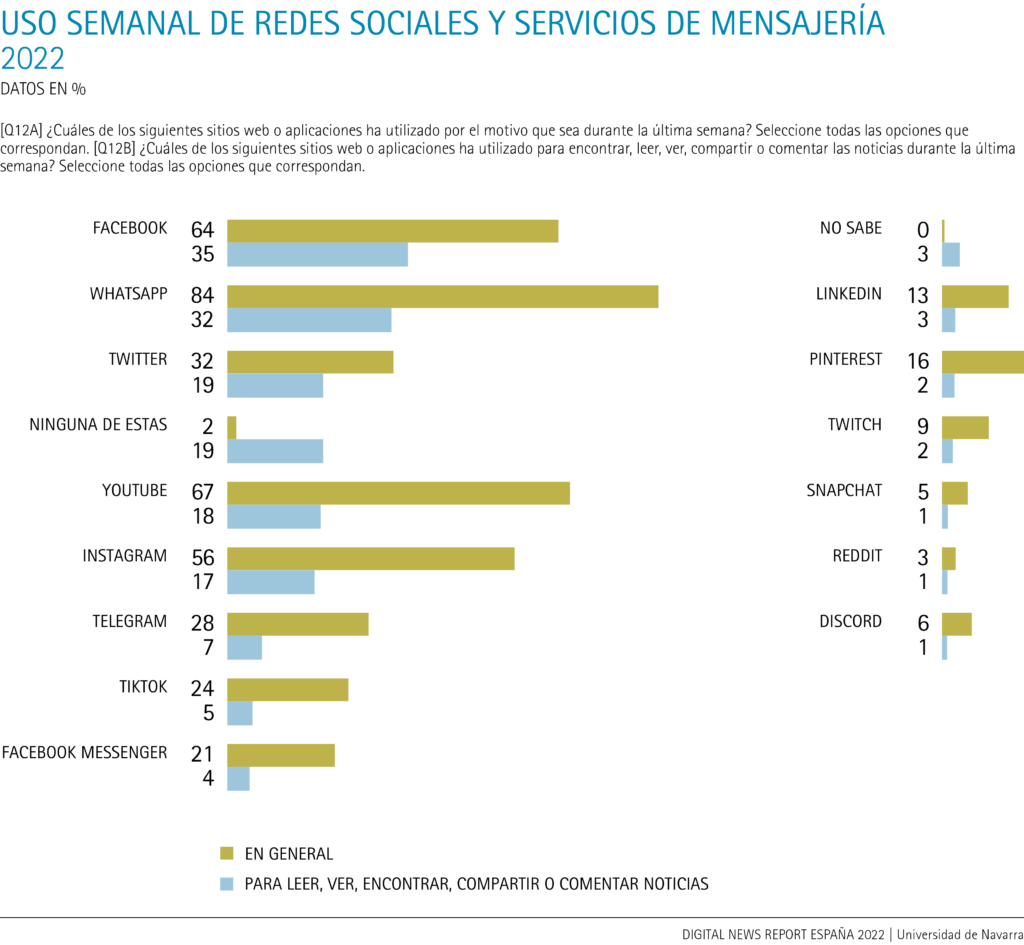
Finally, TikTok 5%), LinkedIn (3%), Pinterest (2%), Twitch (2%), Discord (1%), Snapchat (1%) and Reddit (1%) are not widespread for news consumption in Spain. From this list, the use for news of TikTok barely grows, by 2 percentage points, and Twitch, by 1 point with respect to 2021. Discord, the instant messaging service oriented towards video game communities, also burst onto the scene. It is again B two out of ten respondents say they do not go to any of the social networks included in the Digital News Report to access online news (21%). This behavior is analogous to the average for the 46 countries in the global report (22%).
Twitter and Instagram, favorite networks for the under-35 crowd
Looking at the age brackets of the respondents, it can be seen that the under-35 age group continues to drive information consumption on Twitter (31%) and Instagram (25%). In particular, Twitter is growing by 5 percentage points in this age group compared to 2021. Internet users under 35 also prefer Telegram (10%) -which grows 3 percentage points in the last year in this age group-, TikTok (8%) and Twitch (5%) to check the news. To a lesser extent, Reddit (3%), Snapchat (2%) and Discord (2%). As a result, almost four out of ten people under 35 years of age use an image or video network such as Instagram, YouTube, Snapchat, TikTok or Twitch (39%).
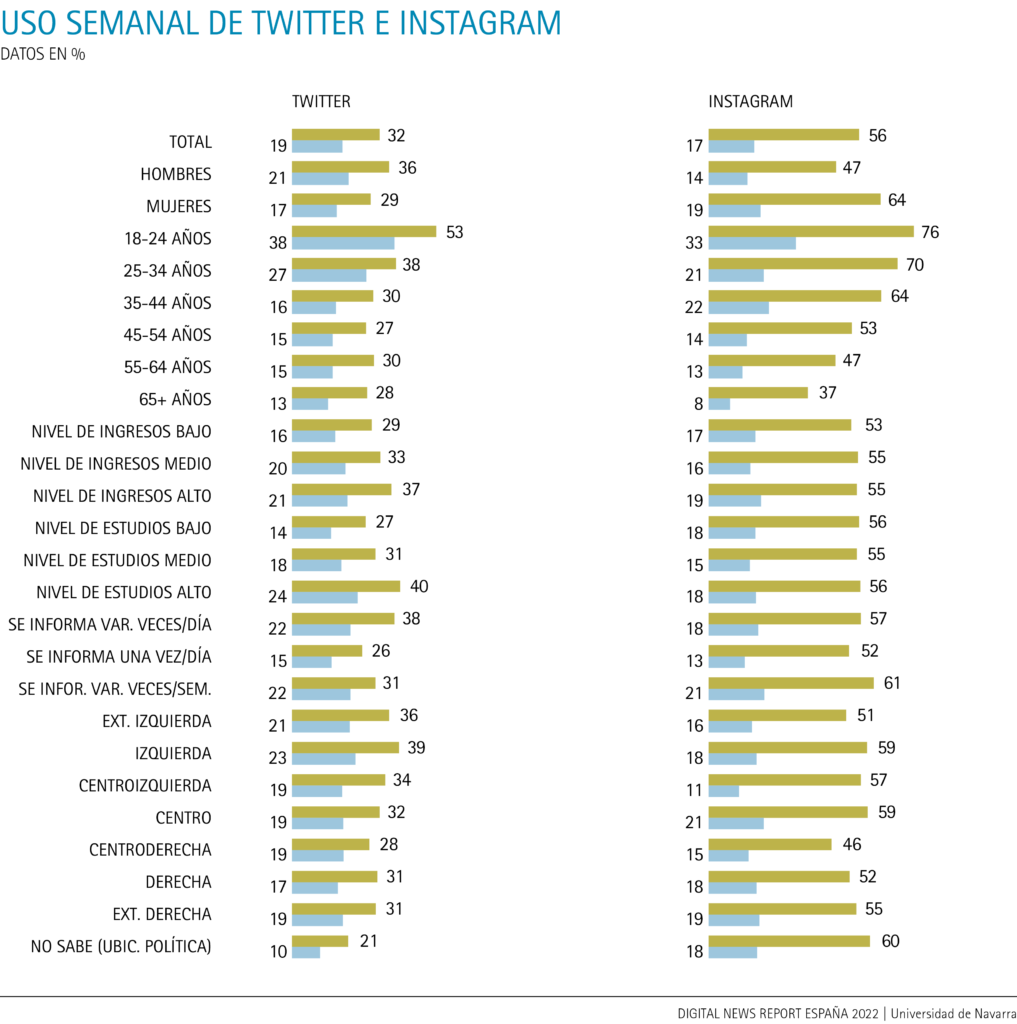
Young people aged 18 to 24 continue to focus their information per diem expenses on Twitter (38%) and Instagram (33%). This is 19 percentage points more in the first case and 16 percentage points more in the second case than the average use of these platforms for news. Young people aged 18 to 24 also prioritize YouTube (23%), which they use by 5 percentage points more compared to the average. However, WhatsApp as a news channel has a lower acceptance in this age group (29%) when compared to the average (32%). Nevertheless, and as in the case of Twitter, almost four out of ten 18-24 year-olds use instant messaging for news (38%). In this regard, young people opt more for Telegram (13%) -6 percentage points above the average of their news use-. Likewise, people aged 18 to 24 encourage the consumption of news on TikTok (10%) -double the average, and Twitch (4%) -which also doubles the average. Other minority networks such as Reddit (4%) and Snapchat (4%) are also used for news by this age profile . The described preferences contribute to the fact that almost half of 18-24 year olds report through an image or video platformInstagram, YouTube, Snapchat, TikTok or Twitch) (47%). This behavior surpasses instant messaging as an information channel for young people (38%).

Meanwhile, the 35+ age group continues to favor Facebook (38%) and instant messaging (38%) for information: almost four out of ten. Among messaging services, WhatsApp stands out for accessing news (34%). However, there is a small decline in the platforms mentioned in this age group . In any case, adults aged 55 to 64 are characterized by consuming news on Facebook: four out of ten (40%). This is 5 percentage points more than their average news use. For their part, adults over 65 years of age prefer messaging services to get news (43%), which they adopt by 7 percentage points above the average. Specifically, four out of ten of adults over 65 use WhatsApp for this activity (41%). That is, 9 percentage points above the average.

Men choose Twitter and YouTube, and women choose Facebook and Instagram.
When considering the gender variable, it is found that men favor the informative use of Twitter (21%) and YouTube (20%). In both cases, this means 4 percentage points more compared to women. Men also opt for Telegram for information (9%), 4 points more compared to women. To a lesser extent, Twitch (3%), Reddit (2%) and Discord (2%) are priority platforms among men. Meanwhile, women consume more news on Facebook (37%) and Instagram (19%). This is a percentage difference of 4 points in the first case and 5 points in the second compared to them.
After combining the variables of gender and age group, it is grade that men under 35 prefer Twitter (32%) for information, while those aged 35 and older opt for instant messaging (39%). Instant messaging is especially popular among men over 65: half of them use it for news (51%). Of these channels, WhatsApp identifies almost half of this gender and age group (48%). Only one in ten of those over 65 use Facebook Messenger for news (10%), although Facebook is a primary information platform for this audience profile (42%). This behavior contrasts with that of men under 35, who four out of ten access news via an image or video network such as Instagram, YouTube, Snapchat, TikTok or Twitch (41%).
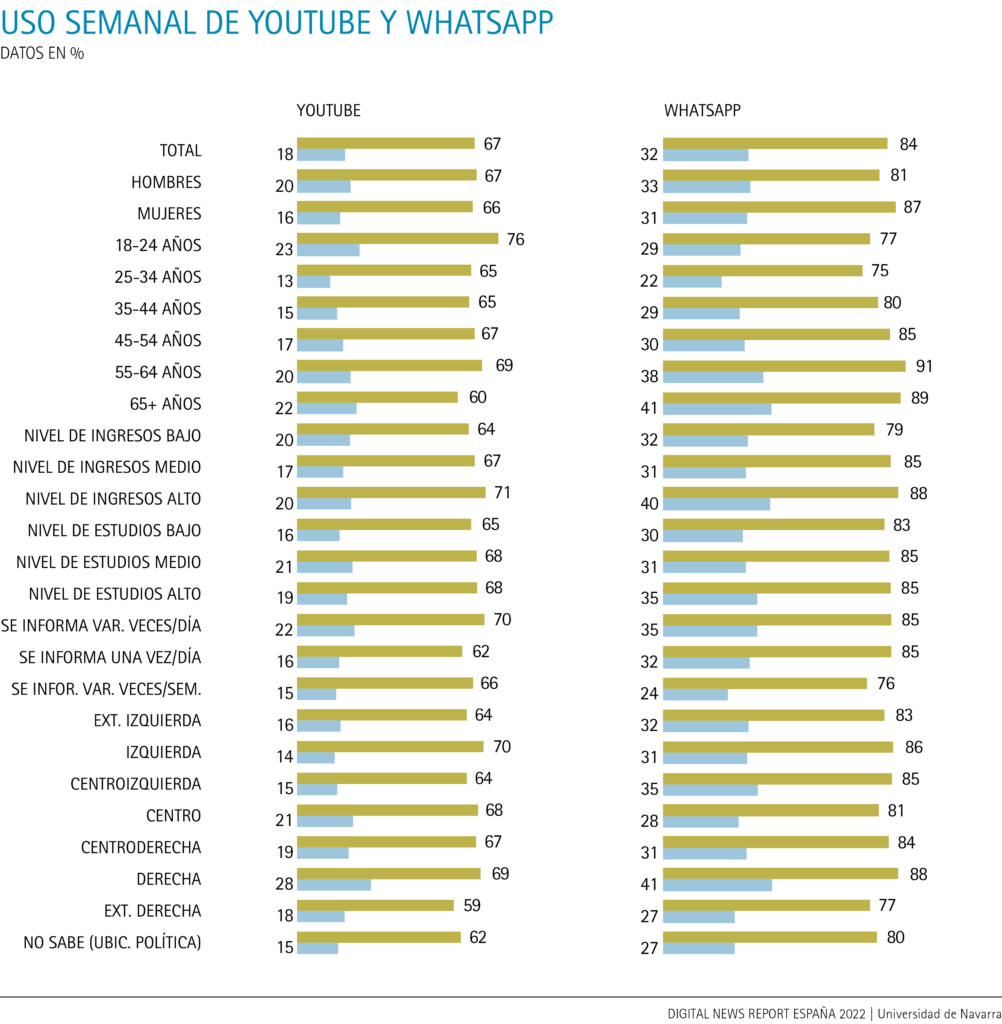
Instagram is the singular information platform for women under 35 (27%), and accounts for 10 percentage points above the average. However, this gender and age group also accesses news via Twitter (30%); and not so much via TikTok (8%). On the other hand, women over 35 are more on Facebook: four out of ten (40%). This is 5 percentage points above the average use of this network for news. Instant messaging is common among women aged 55 to 64 years (42%); and in particular, WhatsApp (38%) which accounts for 6 percentage points above the average. YouTube has a lower informative acceptance among this gender and age group (23%), which is 5 points above the average. Finally, women aged 65 and over are determined to follow the news on Pinterest (6%).
High income and high educational level users prefer WhatsApp and LinkedIn
In reference letter the level of income of the respondents, the informative acceptance of instant messaging services (44%) and LinkedIn (6%) is identified with high-income Internet users. This is a difference of 6 percentage points in the first case and 5 points in the second case when compared to those with a leave income. In particular, the dissatisfaction of WhatsApp (40%) is 8 percentage points; and that of Telegram (9%) is 2 points. The use of Twitch for news is also recognized by people with high income (4%) compared to those with average income (3 percentage points less). Facebook continues to be associated with average income users (38%) -five points above high income-; and, in particular, Facebook Messenger is associated with people with leave income (7%) -three points above high and average income-.
Regarding the educational level of those surveyed, instant messaging services (40%) and LinkedIn (5%) are also the most common networks for consuming news among high educational level Internet users. Twitter (24%) stands out as the second platform for this user profile . In fact, the biggest percentage difference is found for Twitter (10 points) when compared to people with a low educational level. Of the messaging channels, three out of ten people with a high educational level use WhatsApp for news (35%) (5 points more compared to those with a low educational level), and almost one out of ten selects Telegram (8%) (2 points more). The difference for LinkedIn is 4 points. Likewise, the information employment of Facebook is again related to low educational level Internet users (40%) (12 percentage points more compared to those with a high educational level). YouTube stands out among people with a medium educational level (21%) (5 percentage points more than those with a low educational level). Instagram as an informative platform is no longer linked to users with a higher level programs of study.
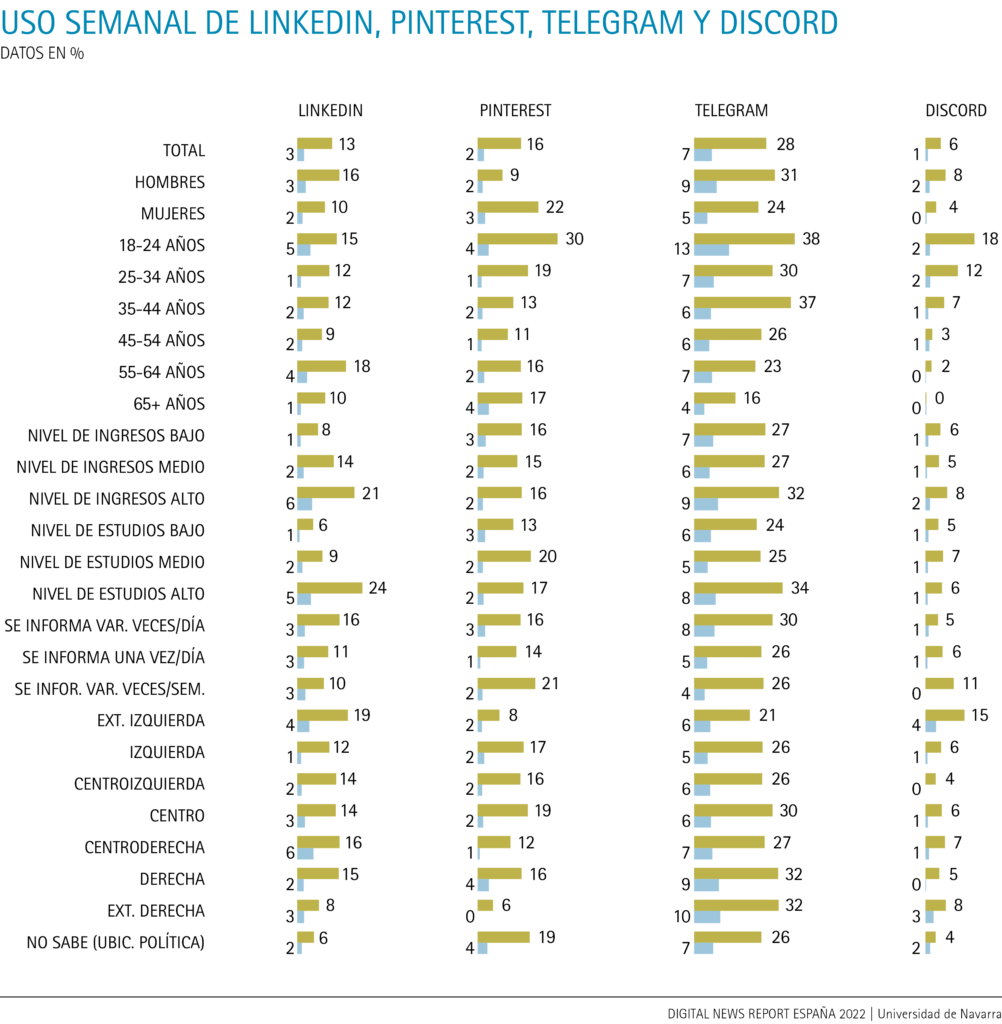
The public located on the political right is betting on image or video networks.
When looking at the political leanings of the respondents, it can be seen that the public on the right uses instant messaging services more for news: four out of ten (43%). In the case of WhatsApp, it is almost four out of ten (38%). Internet users who declare themselves to be right-wing also go to YouTube (26%) and do so to a greater extent than last year when this platform was linked to the political center public. Similarly, news consumption on Telegram continues to be linked to right-wing users, albeit only in the case of one in ten (10%). Therefore, it is still significant that almost four out of ten people on the political right consume news on an image or video network Instagram, YouTube, Snapchat, TikTok or Twitch) (39%).
However, the public that places itself on the political left bets more on the informative use of Twitter (23% or two out of ten). On the other hand, the public that claims to be in the political center is slightly more represented on LinkedIn (3%). It is also noteworthy that almost four out of ten Internet users who consume news on Facebook say they do not know where they stand politically (37%). The same is true for almost three out of ten users who choose other social networks not included in the Digital News Report to get information (29%). Almost one in ten people who use TikTok 7%) or Discord (2%) do not know how to state their political position either.
Frequency of access to news
Regarding respondents' interest in information, it is grade that the employment certain networks is positively related to the frequency of access to news. Thus, four out of ten Internet users who consume information through instant messaging (40%) and Facebook (41%) consult the news several times a day. Among them, those who use WhatsApp (35%). Also, two out of ten of Twitter (22%) and YouTube (22%). The predisposition to be informed is more leave in the case of Instagram: several times a week (21%) and several times a day (18%). In this line, two out of ten Internet users who do not resort to the platforms included in the Digital News Report and say they access the news once a day (26%). Finally, one in ten people who do not know the answer to this question only access news several times a week (9%).
Appreciation of media content on the platforms.
Half of the respondents who use Twitter for information say that what they see in their feeds comes from the news media (49%). In particular, almost four out of ten people in the under 35 age group consider the level of this content subject to be high (37%) compared to three out of ten Internet users in general who consider the level to be low (33%) - in particular those in the political center (37%).
A similar evaluation is given by respondents who use Facebook for news. Almost half of them say that what they see in their feeds comes from the media (47%). This statement is more significant among the leave internet users (50%) and those located on the political right (50%). In line with Twitter, it is the audience under 45 years old that understands that media content on Facebook is of a high standard: almost four out of ten (39%). Three in ten of high income (38%) and high educational level (38%) rate it as low.
Instagram s informative appreciation is lower among respondents, with almost three out of ten confirming that what they see in their feeds comes from the media (27%). These are, in particular, the public under 35 years of age (32%), and Internet users in general of leave income (33%), low educational level (32%) and those positioned in the political right (36%). Three out of ten users of this platform claim that this subject of content reaches both a low level (34%) and a high level (33%). People with a high income (39%), those with a high educational level (39%), and those on the political left (38%) and center (37%) are more inclined to the first assessment; specifically, adults between 55 and 64 years old (40%). On the other hand, people with a leave income leave 38%) and those on the political right (37%) opt for the second assessment
Finally, TikTok s information appreciation is even less relevant as only two out of ten respondents say that what they see in their feeds comes from the media (25%). In particular, the income leave audience (30%) and those on the political right (31%). As with Instagram, three in ten internet users who use TikTok for news perceive the level of this content to be low (34%) as well as high (32%). People with a high educational level opt more for the first assessment (39%); and people with a leave income (41%) and men (40%) for the second one.
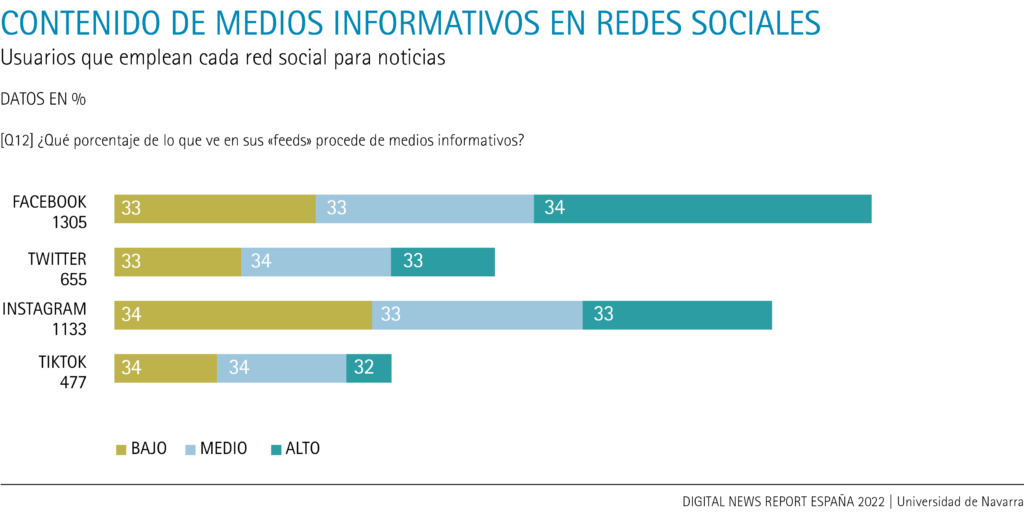
When assessing the amount of media content seen on the networks, the majority of respondents consider this to be adequate. Seven out of ten people who access news from Twitter say that this content is adequate (75%). This is more relevant for audiences under 35 years old (82%) and those with an average level educational (80%). In contrast, almost one in ten think that media content on Twitter is insufficient (9%) or excessive (8%). Those over 55 stand out for not answering this question (12%).
Likewise, six in ten respondents who use Instagram for news state that the amount of media content on this platform is adequate (63%). This is more characteristic of men under 35 (75%), adults in general aged 55-64 (68%), the leave income audience (68%) and those located on the political right (70%). In addition, 16% do not know how to answer this question - 22% among women aged 45 to 54 - or feel that the media content is not sufficient (13%) - specifically, those under 35 (17%) and those in the high income bracket (18%). Similarly, one in ten Instagram users for news express that media content is too much (8%) -especially women under 35 (14%)-.
In turn, six out of ten respondents who get information on Facebook also say that the media content on this network is adequate (61%). In particular, the public under 35 years of age (66%), those with a high educational level (64%) and those on the political right (64%). As in the case of Instagram, one in eight Internet users who read and watch news on Facebook ratifies that the media content is excessive (12%). Mainly, these are people of leave income (15%) and medium educational level (9%). Also, one in eight say it is insufficient (12%); especially women aged 45 to 54 (17%). In addition, 15% do not answer this question.

Finally, nearly six in ten respondents who use TikTok for news say that the media content on this platform is adequate (59%). This is most telling for audiences under 35 (67%), those with average income (64%) or average educational (65%), and those on the political left (70%). However, almost two in ten believe that the media content on TikTok is insufficient (18%), especially women aged 35 and over (23%). In addition, one in eight do not know the answer to this question (12%) - mainly men aged 45 and over (18%) and people from the political center (15%). Likewise, one in ten reiterates that the media content on TikTok is excessive (10%). This is more so among men aged 35 and older (17%).